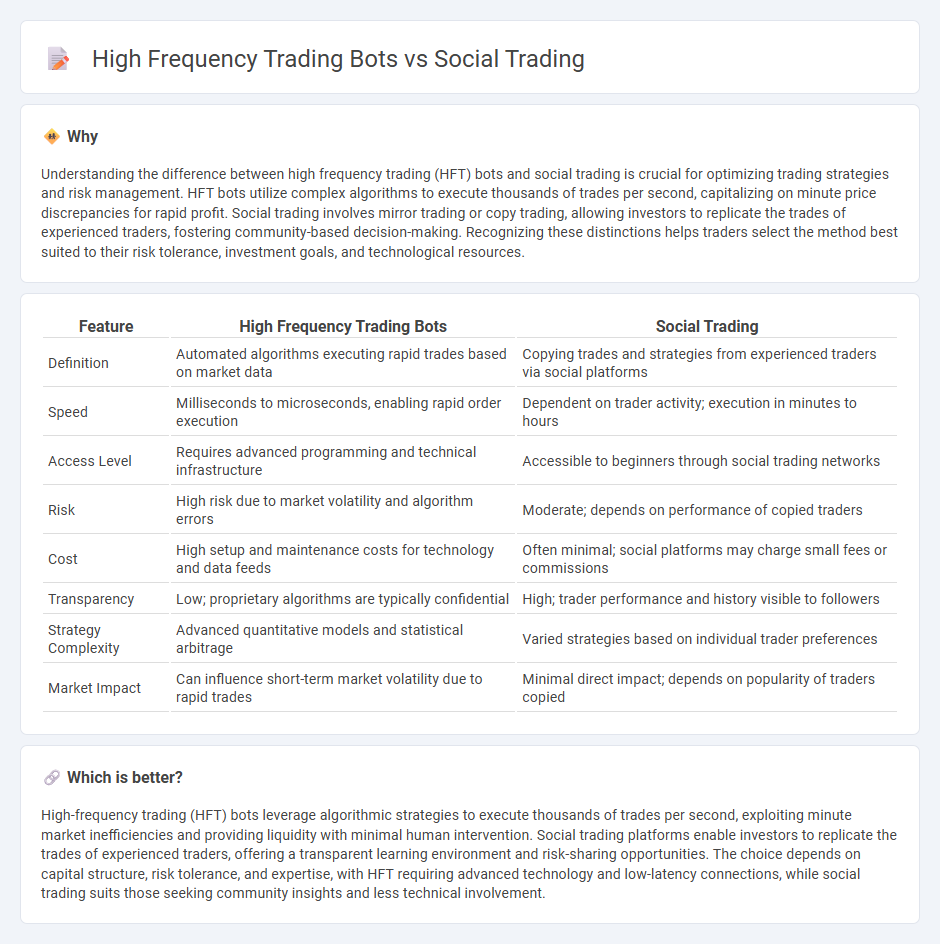
High-frequency trading (HFT) bots leverage advanced algorithms and ultra-low latency networks to execute thousands of orders per second, capitalizing on minute market inefficiencies for rapid profit. Social trading platforms, on the other hand, prioritize community-driven strategies where traders follow or copy experienced investors' moves in real time, fostering transparent decision-making. Explore the distinct advantages and challenges of HFT bots versus social trading to determine the best fit for your investment goals.
Why it is important
Understanding the difference between high frequency trading (HFT) bots and social trading is crucial for optimizing trading strategies and risk management. HFT bots utilize complex algorithms to execute thousands of trades per second, capitalizing on minute price discrepancies for rapid profit. Social trading involves mirror trading or copy trading, allowing investors to replicate the trades of experienced traders, fostering community-based decision-making. Recognizing these distinctions helps traders select the method best suited to their risk tolerance, investment goals, and technological resources.
Comparison Table
| Feature | High Frequency Trading Bots | Social Trading |
|---|---|---|
| Definition | Automated algorithms executing rapid trades based on market data | Copying trades and strategies from experienced traders via social platforms |
| Speed | Milliseconds to microseconds, enabling rapid order execution | Dependent on trader activity; execution in minutes to hours |
| Access Level | Requires advanced programming and technical infrastructure | Accessible to beginners through social trading networks |
| Risk | High risk due to market volatility and algorithm errors | Moderate; depends on performance of copied traders |
| Cost | High setup and maintenance costs for technology and data feeds | Often minimal; social platforms may charge small fees or commissions |
| Transparency | Low; proprietary algorithms are typically confidential | High; trader performance and history visible to followers |
| Strategy Complexity | Advanced quantitative models and statistical arbitrage | Varied strategies based on individual trader preferences |
| Market Impact | Can influence short-term market volatility due to rapid trades | Minimal direct impact; depends on popularity of traders copied |
Which is better?
High-frequency trading (HFT) bots leverage algorithmic strategies to execute thousands of trades per second, exploiting minute market inefficiencies and providing liquidity with minimal human intervention. Social trading platforms enable investors to replicate the trades of experienced traders, offering a transparent learning environment and risk-sharing opportunities. The choice depends on capital structure, risk tolerance, and expertise, with HFT requiring advanced technology and low-latency connections, while social trading suits those seeking community insights and less technical involvement.
Connection
High frequency trading (HFT) bots and social trading intersect through the rapid execution of trades influenced by real-time insights from peer networks. HFT bots analyze social trading platforms' data streams to identify emerging market trends and mimic successful traders' strategies at lightning speeds. This integration enhances market responsiveness, liquidity, and the democratization of trading opportunities for individual investors.
Key Terms
Copy Trading
Copy trading allows investors to replicate the trades of experienced traders, providing a hands-off approach to market participation that leverages collective expertise. High-frequency trading bots execute numerous trades at extremely fast speeds using complex algorithms, focusing on short-term market inefficiencies and requiring significant technological infrastructure. Explore the advantages and risks of copy trading strategies to better understand how to enhance your investment portfolio.
Algorithmic Execution
Algorithmic execution in social trading relies on community-driven strategies, enabling investors to mimic top traders' decisions through automated platforms, while high-frequency trading (HFT) bots execute rapid, algorithm-based trades exploiting short-term market inefficiencies with ultra-low latency. Social trading algorithms prioritize transparency and collective insights, contrasting with HFT bots' focus on speed, precision, and complex quantitative models. Explore the distinct advantages and technological nuances between social trading and HFT bots to optimize your trading strategy.
Latency
Latency plays a critical role in high-frequency trading bots, where milliseconds can determine profitability by enabling rapid execution of trades based on real-time market data. Social trading, however, prioritizes strategy replication and community insights over ultra-low latency, making it more accessible for retail investors who do not require instantaneous trade execution. Explore the nuances of latency impact on trading performance and strategy effectiveness to optimize your trading approach.
Source and External Links
Social Trading Explained for Beginners at JustMarkets - Social trading allows traders to follow and copy the strategies of successful peers while maintaining full control of their investments, offering a simpler way for new traders to learn and potentially earn higher returns.
Social trading - Wikipedia - Social trading is a form of investing that lets traders observe, copy or mirror the trades of others in real time, integrating social indicators into investment decisions to shorten learning curves.
Social Trading: Everything You Need To Know - Social trading platforms enable investors to join a community, follow experienced traders, automatically copy their trades and adjust strategies while being aware of risks involved, especially with leveraged CFDs.
 dowidth.com
dowidth.com